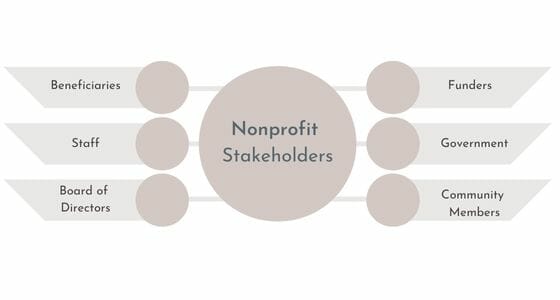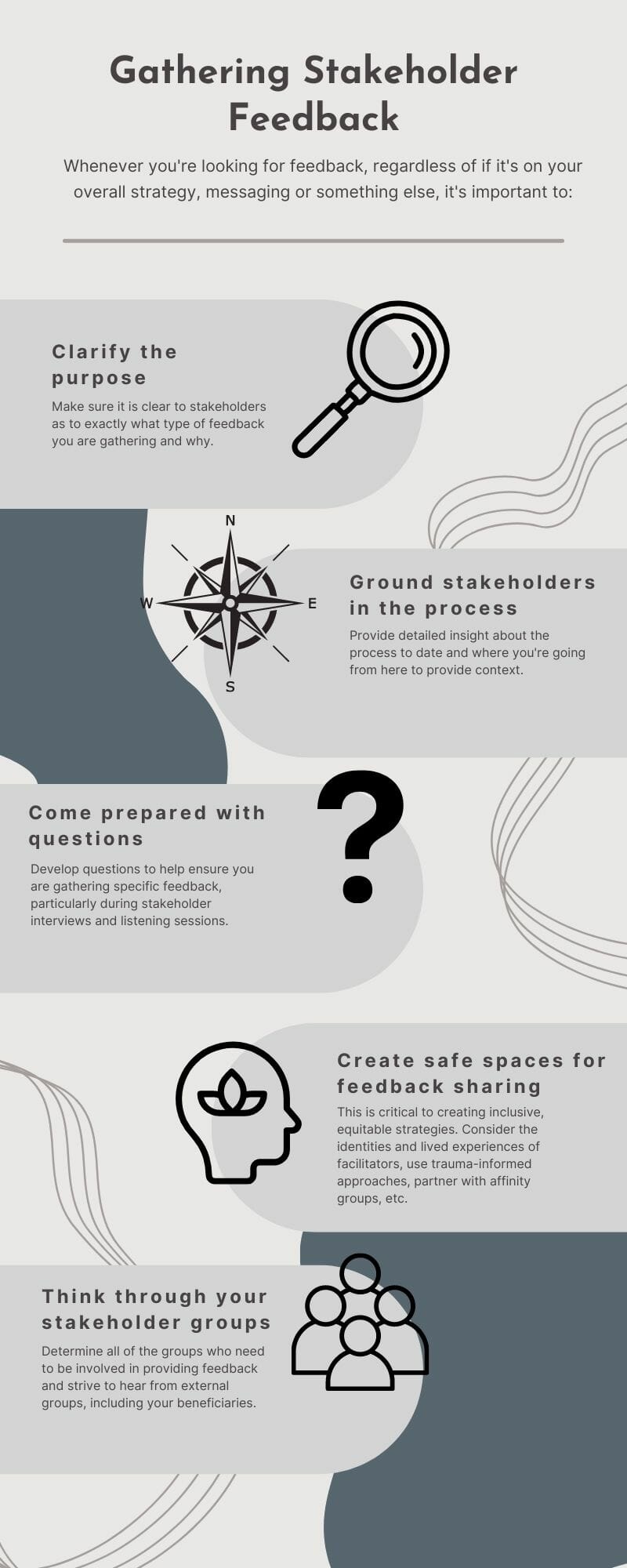Gathering stakeholder feedback at the beginning of a strategy development process is nothing new in the nonprofit world. It’s something the sector, and the consultants who support it, have been doing for years. However, as we strive to build more inclusive, equitable and actionable strategies, gathering feedback from stakeholders only at the onset of a strategy development process is simply not enough.
Stakeholder feedback needs to be baked into every part of strategy development. Yes, it takes more time. Yes, incorporating feedback from multiple parties and multiple vantage points is a challenge, but the end result is a far more impactful strategy, stronger key messages, resonant vision and mission statements and more.
This is the crux of our Shared Power StrategyTM philosophy, which is an approach to creating strategies hand-in-hand with your nonprofit’s many diverse stakeholders, and most importantly, the communities you exist to serve.

The case for gathering nonprofit stakeholder feedback throughout strategy development
You might say, “is this really necessary? I think we have a really good idea of what our stakeholders need and want.”
It’s true, you might, but we’ve seen this thinking proven wrong now, time and time again. Let me give you an example. We recently worked with a cultural center on their strategic plan. This center was under the leadership of a new CEO. As part of the CEO’s onboarding process, and to inform the strategic plan, we conducted stakeholder interviews and surveys to get a pulse on community perspectives at the beginning of the strategic planning process. Following this initial research, it was clear that community members were passionate about the organization taking a stand on social justice.
This perspective became the underpinning of one of the center’s strategic plan priorities (or as we call them at Prosper, strategic plan pillars). However, when we shared this pillar, along with the others, with stakeholders, they wanted the center to go even deeper. This feedback led the board and staff to rethink the center’s overall positioning. As a result, they modified their mission statement and revisited their strategic plan pillars to determine how their work across not just one, but every pillar, would serve to advance social justice issues.
In the absence of re-sharing the plan with their stakeholders, the final result would not have been as powerful or transformative for the center or its stakeholders.
Best practices for gathering stakeholder feedback throughout strategy development
As we’ve discussed before, there are multiple ways to gather feedback, from surveys and focus groups to interviews and listening sessions. These tools can be used on their own and collectively to gather inputs needed to drive your strategy forward. In this post, we’ll discuss when feedback should be gathered, based on which strategic elements you are developing.
Whenever you’re looking for feedback, regardless of if it’s on your overall strategy, messaging or something else:
- Clarify the purpose: why are you gathering this feedback?
- What exactly are you looking for from stakeholders during this phase? Develop questions to gather specific feedback
- Ground stakeholders in the process to date and the process going forward
- Create safe spaces for feedback sharing to make strategy development more equitable and inclusive
- Use this stakeholder worksheet to determine who needs to be involved in providing feedback on your nonprofit strategies

When to gather stakeholder feedback, depending on which strategic element your nonprofit is developing
Stakeholder feedback on nonprofit messaging
Start by creating an internal draft of key messages. These can include overarching points about your nonprofit or specific campaign related messaging or concepts. It’s these draft statements you’ll want to test with stakeholders. Many organizations already do this with board members, donors and funders. We advocate for prioritizing program participants and beneficiaries in this testing as well. Why? Because you want to make sure that your messaging represents the individuals and communities you exist to serve in ways that feel true and empowering to them (learn more about strength-based communication).
Who needs to be involved in providing feedback on nonprofit key messages?
- Organizational leadership
- Board members (often a board marketing or communications committee)
- Donors/funders
- Program participants, clients, people who use your organization’s services, other beneficiaries
When should you garner stakeholder input on key messages?
Stakeholder input should be gathered once you have an internal working draft of key messages developed that are complete enough to give stakeholders something to react to, but not so complete that they can’t be modified based on feedback.
Questions you might ask stakeholders about your key messages include:
- Do these key messages accurately and authentically represent the individuals and communities we serve?
- Is there anything that feels inaccurate?
- Are there any words you find particularly powerful?
- Conversely, are there any words you dislike or that you feel misrepresent our work or the community we serve?
Stakeholder feedback on nonprofit vision and mission statements
Typically organizations create their vision and mission statements through creative workshops. These workshops should be made up of leadership, staff and board members. However, the work doesn’t start and end there. Gathering feedback from other members of the board, staff and your nonprofit’s beneficiaries is critical for shaping the most authentic statements possible.
Who needs to be involved in providing feedback on nonprofit vision and mission statements?
- Organizational leadership
- Staff
- Board strategy committee
- All board members
- Program participants, clients, people who use your organization’s services, other beneficiaries
When should you garner feedback from stakeholders on your vision and mission statements?
You should aim to gather feedback on your nonprofit vision and mission statements once you have drafts developed as a result of your creative workshops.
Likely, during these workshops, questions will come up from the working group: Do we like this word or that word? Should we put this phrase ahead of that phrase? Do we like a “a world where” or a “future where?”, etc. You’ll want to pay attention to and note these questions, so when you put the statements before wider groups of stakeholders, you can directly ask them for their thoughts and opinions.
Stakeholder feedback on nonprofit values statements
Like vision and mission development, nonprofit values statements are typically created workshop-style. However different from vision and mission, these are very internally facing statements. They typically don’t require board sign-off or robust external stakeholder input.
Who needs to be involved in providing feedback on nonprofit values statements?
- Organizational leadership
- Staff
When should you gather feedback from leadership and staff?
Your values statements guide your organization’s staff and team. Therefore, while a core group of staff may initially create the draft values statements, they should be shared with the entire team for feedback and input before they are finalized.
Stakeholder feedback on your nonprofit strategic plan
It’s important to note that vision and mission development is often baked into strategic planning. If this is the case at your nonprofit, you’ll have your first stakeholder engagement opportunities at that point, and follow the process outlined above. The next time you gather stakeholder feedback will be in regards to your draft strategic plan pillars and objectives.
Who needs to be involved in providing feedback on nonprofit strategic plan pillars and objectives?
- Organizational leadership
- Staff
- Board strategy committee
- All board members
- Donors and funders
- Program participants, clients, people who use your organization’s services, other beneficiaries
When should you gather feedback from stakeholders on your nonprofit strategic plan pillars and objectives?
Pillars and objectives are often developed during a strategic planning retreat, where nonprofit leadership, and sometimes board members, come together to envision the next three years, discuss priorities and hone in on what the next strategic plan needs to address. Following these sessions is when you want to get feedback from your nonprofit’s larger set of stakeholders.
You’ll want to ask questions like:
- Do you agree with this overall strategic direction?
- Is there anything you’re particularly excited about?
- Is there anything we’re missing?
You can vary your questions based on the audience you’re gathering feedback from.
Hopefully at this point, I’ve made the case for why involving stakeholders not just at the beginning, but throughout the strategy development process is so important. And, you also have a better understanding of who you should and involve when. So let’s continue creating more equitable, inclusive strategies to propel the nonprofit sector forward.